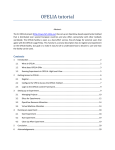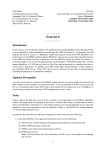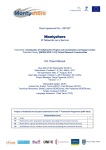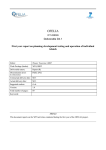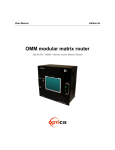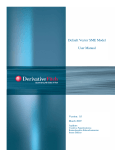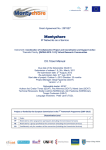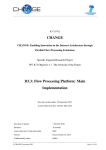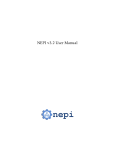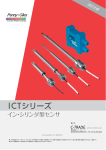Download open/download tutorial
Transcript
OFELIA tutorial Abstract: The EU OFELIA project (http://www.fp7-ofelia.eu/) has set-up an OpenFlow-based experimental testbed that is distributed over several European countries and also offers connectivity with other testbeds worldwide. The OFELIA facility is open as a best-effort service, free-of-charge for external users that agree with the OFELIA Usage Policy. This Tutorial is a concise description how to register and experiment on the OFELIA facility. Our goal is to make it easy for all to understand how to become a user and how the facility can be used. Contents 1 2 3 4 Introduction .......................................................................................................................................... 2 1.1 What is OFELIA .............................................................................................................................. 2 1.2 What does OFELIA Offer ............................................................................................................... 3 1.3 Running Experiments in OFELIA: High Level View ........................................................................ 5 Getting Access to OFELIA ...................................................................................................................... 6 2.1 Register ......................................................................................................................................... 6 2.2 Configure the VPN to Access the OFELIA Testbed ........................................................................ 7 2.3 Login to the OFELIA Control Framework....................................................................................... 9 Setting up an Experiment...................................................................................................................... 9 3.1 Managing Projects ...................................................................................................................... 10 3.2 Slices for Experiments ................................................................................................................. 12 3.3 OpenFlow Resource Allocation ................................................................................................... 14 3.4 Virtual Machine Allocation ......................................................................................................... 14 Running an experiment....................................................................................................................... 18 4.1 Start Experiment ......................................................................................................................... 18 4.2 Run Experiment........................................................................................................................... 19 4.3 Clean Up After Experiment ......................................................................................................... 19 5 Conclusion ........................................................................................................................................... 20 6 Acknowledgements............................................................................................................................. 20 OFELIA Tutorial Table 1: The OFELIA islands – brief description and links to detailed information ...................................... 4 Figure 1: Map of OFELIA island locations in Europe ..................................................................................... 3 Figure 2 OFELIA Page for Registration of New Users .................................................................................... 7 Figure 3: OFELIA Page for Login to OFELIA.................................................................................................... 8 Figure 4: OFELIA Experimenter Welcome Page ............................................................................................ 8 Figure 5: OFELIA Expedient Dashboard at First Login ................................................................................. 10 Figure 6: OFELIA Project Management Page .............................................................................................. 11 Figure 7: OFELIA Slice Management Page .................................................................................................. 13 Figure 8: OFELIA Slice Management Page – Area Network Resources, OpenFlow Aggregate ................... 15 Figure 9: OFELIA Slice Management Page – Area Computational Resources, VT Aggregate ..................... 15 Figure 10: OFELIA OpenFlow Resource Allocation page ............................................................................. 16 Figure 11: Fields to define OFELIA FlowSpace ............................................................................................ 17 Figure 12: OFELIA Page for Setting the Controller IP Address .................................................................... 17 Figure 13: Example FlowSpace.................................................................................................................... 18 1 Introduction The EU OFELIA project (http://www.fp7-ofelia.eu/) has set-up an OpenFlow-based experimental testbed that is distributed over several European countries and also offers connectivity with other testbeds worldwide. This Tutorial is a concise description of how to register and experiment on the OFELIA facility. More detailed information about OFELIA and its resources can be found on the OFELIA website and user manual. The OFELIA facility is open as a best-effort service, free-of-charge for external users that agree with the OFELIA Usage Policy. 1.1 What is OFELIA OFELIA is a collaborative project within the European Commission’s FP7 ICT Work Programme. Its name stands for OpenFlow in Europe: Linking Infrastructure and Applications. The OFELIA project offers a Pan-European testbed to the research community for conducting experiments in an OpenFlow-enabled wide-area network. The flow-based virtualized OFELIA environment enables researchers to change the network behavior as a part of their experiments on innovative network protocols and applications. The aim of OFELIA is to provide an experimentation space which allows for flexible integration of test and production traffic by isolating the traffic domains inside the OpenFlow enabled network equipment. Page 2 of 20 OFELIA Tutorial This allows for providing realistic test scenarios and for seamless deployment of successfully tested technology. The OFELIA experimental facility is based on OpenFlow technology that allows researchers to not only experiment “on” a test network but to control the network itself precisely and dynamically. 1.2 What does OFELIA Offer Eight interconnected islands (Figure 1) based on OpenFlow infrastructure are available to allow experimentation on multi-layer and multi-technology networks. A brief description of each island is provided in Table 1. As a federated facility, all OFELIA islands are connected together (Intra-Federation) providing diverse and scalable resources. A single login will grant access to all islands. Work is ongoing to allow experiments to span across different islands. In the future, the OFELIA testbed will also support “Inter-Federation” procedures that enable resource export and import across with other large scale test-bed facilities. In particular, OFELIA is working to inter-federate with GENI, PlanetLab, OMF1. Figure 1: Map of OFELIA island locations in Europe 1 OMF – Orbit Management Framework; a control and management framework for networking testbeds Page 3 of 20 OFELIA Tutorial All OFELIA Islands will support running layer2/3 experiments on real OpenFlow-enabled hardware switches. Many diverse experiments can be done on the various islands like e.g. run wireless experiments on TUB Island, information-centric networking experiments on CNIT Island (becoming available soon), optical experiments on UEssex Island, or experiments on virtual topologies (VeRTIGO) on Create-Net Island. Various kinds of experiments can be run on the OFELIA islands (see Table 1 for brief descriptions of the islands). An exemplary and not exhaustive list of experiments that can be run over OFELIA is: • • • • • • • • • Ability to run OpenFlow applications on user controller/NOS (networking operating system) e.g. routing, monitoring, PCE apps to make best use of OpenFlow abstractions. Testing of new forwarding and routing protocols using OpenFlow as the basic enabling protocol and API Experiments leveraging virtualization capabilities (VMs, sliced resources) to create virtual networks and use them for testing layer-2 and above virtualization schemes Experiments where real end-users can contribute (opt-in) real traffic in order to test realistic experimental scenarios Experiments over wireless networks (WiFi-based) Emulations of large wired and wirless networks Experiments on an optical OpenFlow based network Information Centric Networking related experiments …. Note the above list is incomplete and unordered. Table 1: The OFELIA islands – brief description and links to detailed information Island Berlin (TUB) Brief description Partial replacement of existing campus network with OpenFlow enabled switches Link to island detailed status and resources information: https://alpha.fp7-ofelia.eu/doc/index.php/Testbed_Berlin_Campus Link to island Expedient GUI: https://exp.tubit.fp7-ofelia.eu/ Ghent (IBBT) Central hub, large-scale emulation Link to island detailed status and resources information: WiLab: https://alpha.fp7-ofelia.eu/doc/index.php/Testbed_Belgium_Wilab Virtual Wall: https://alpha.fp7ofelia.eu/doc/index.php/Testbed_Belgium_Virtual_Wall Link to island Expedient GUI: https://exp.ibbt.fp7-ofelia.eu/ Page 4 of 20 OFELIA Tutorial Island Zürich (ETH) Brief description Connection to OneLab and GENI Link to island detailed status and resources information: https://alpha.fp7-ofelia.eu/doc/index.php/Testbed_Zurich Link to island Expedient GUI: https://exp.ethz.fp7-ofelia.eu/ Barcelona (i2CAT) L2 switches and Optical equipment (ROADM ring) Link to island detailed status and resources information: https://alpha.fp7-ofelia.eu/doc/index.php/Testbed_Barcelona Link to island Expedient GUI: https://exp.i2cat.fp7-ofelia.eu/ Essex (UEssex) National hub for UK optical community; L2 switches and L1/L0 ROADMs (optical mesh network), FPGA testbed Link to island detailed status and resources information: https://alpha.fp7-ofelia.eu/doc/index.php/Testbed_Essex Link to island Expedient GUI: https://exp.uessex.fp7-ofelia.eu/ Rome and Catania (CNIT) Two islands with focus on Information Centric Networking Under deployment as of July 2012. Trento (CREATE-NET) A city-wide distributed island based on L2 switches and NetFPGA; opt-in users via heterogeneous access technologies Link to island detailed status and resources information: https://alpha.fp7-ofelia.eu/doc/index.php/Testbed_Trento Link to island Expedient GUI: https://exp.create-net.fp7-ofelia.eu/ 1.3 Running Experiments in OFELIA: High Level View In order to run experiment in OFELIA, you first need to setup your own OFELIA account. OpenVPN is used to connect into the OFELIA federated test-beds. For security reasons the OFELIA islands are not directly connected with the Internet. Using a web browser, you can create and manage your experiments through the OFELIA Expedient GUI, a graphical web-based interface to the “OFELIA Control Framework”. In particular you can: Create and configure your own slice of network resources. Such a slice is a subset of the physical links and OpenFlow switches which make up an island. Create and manage a set of Linux Virtual Machines (VMs) that will be hosted in the island servers. VMs can serve as traffic sources and sinks, and can be used to run the experiment’s application(s). One of your VMs usually hosts the OpenFlow controller. Some “default” OpenFlow controllers are provided by OFELIA and can be easily configured and run, but you are free to install and use any controller on your VMs. For the access to your VMs SSH will be used. For the monitoring of experiments and for the collection of measurements and statistics, OFELIA is working to provide monitoring tools that will be integrated into the OFELIA Framework. Page 5 of 20 OFELIA Tutorial 2 Getting Access to OFELIA The OFELIA facility is open as a best-effort service, free-of-charge for external users that agree with the OFELIA Usage Policy. The links to the OFELIA login and the user manual, as well as general information about how to experiment can be found on the OFELIA website at page http://www.fp7-ofelia.eu/ofelia-facility-andislands/how-to-experiment/. 2.1 Register Before connecting to an OFELIA island for the first time, you have to register and acquire an OFELIA user account. To register, open the URL https://fuzzy.eict.fp7-ofelia.eu/registration/register (Figure 2 for the screenshot). You need to Provide your name, e-mail address, password, and the organization you belong to Select your home island Selecting a home island does not restrict your experiments to that island, but helps to run specific experiments supported by that particular island, e.g. Optical, wireless. Since the facilities are federated users can reserve any resource available from any of the OFELIA test-beds. Accept the OFELIA usage policy A link to the usage policy document is provided on the registration page. And enter your public key OFELIA uses SSH/DSA keys for authentication. A key pair can be generated with the command ssh-keygen -t dsa in a (Linux) shell. Please note that the exact command may be slightly different, depending on the operating system and SSH software you run on. Then open the generated public key and paste it into the field. Upon submission of the registration information, you will receive an automatically generated e-mail for confirmation. After the confirmation you will receive another email that your registration was successful. The e-mail contains a link to the OFELIA login page and your login. Page 6 of 20 OFELIA Tutorial Figure 2 OFELIA Page for Registration of New Users 2.2 Configure the VPN to Access the OFELIA Testbed For security reasons, OFELIA's experimental environment is accessible only via gateways. Connecting to the facility happens through OpenVPN connections through the hub in Ghent. After successful registration you login to OFELIA via https://fuzzy.eict.fp7-ofelia.eu/ (please see Figure 3 for the screenshot). Use your login and password credentials. If you forgot your current password, you can reset it by clicking on reset your password. Page 7 of 20 OFELIA Tutorial Figure 3: OFELIA Page for Login to OFELIA Upon successful login, you will be directed to the OFELIA welcome page (see Figure 4) which contains the OFELIA OpenVPN configuration tarball, and the links to the manual (documentation wiki) and the OFELIA public website. Figure 4: OFELIA Experimenter Welcome Page Page 8 of 20 OFELIA Tutorial You download the OpenVPN configuration (click on the hyperlink behind this text) which is needed to access the OFELIA control framework. Use the ofelia.conf file to configure your OpenVPN and install the security certificate ca-ofeliarouted.crt. Both are contained in the configuration tarball. OpenVPN must be installed on your machine. For a detailed description on how to set-up the VPN, please refer to the OFELIA user manual at https://alpha.fp7-ofelia.eu/doc/index.php/VPN_setup. Make sure that your DNS is set-up appropriately to automatically resolve the internal OFELIA DNS names. The OFELIA DNS IP address is 10.216.24.2. The address is also provided at this page: https://alpha.fp7ofelia.eu/doc/index.php/Working_with_the_OFELIA_Control_Framework#Registration_and_logging. You may have to ask your system/network administrator to enable these configurations. All the OFELIA users should accept and follow the Facility Usage Policy. 2.3 Login to the OFELIA Control Framework After successful registration and OpenVPN setup, you can login to the OFELIA Control Framework User Interface. You will be forwarded to the Expedient Dashboard. OFELIA's Control Framework Web interface is called Expedient and is one of the components of the OFELIA Control Framework. It enables experimenters to create and run experiments within the OFELIA autonomous and federated facilities. Through this user interface, you can instantiate and deploy experiments, which may include virtual machines, switch configurations and other resources. The control framework handles the separation of the experiments, the starting and stopping of virtual machines and experimental slices, and displays resource states. You first have to decide on which testbed island you want to login; usually this is your home island. Point your browser to the island-URL of your choice. OFELIA island-URLs have the form https://exp.ISLANDID.fp7-ofelia.eu. For the exact URLs, please refer to Table 1 on page 4. Make sure your OpenVPN connection into OFELIA is up and running before trying to reach your selected island’s Expedient via the web browsers. After providing your login credentials, you will be directed to the OFELIA Expedient Dashboard (see Figure 5). Your credentials are valid across all islands. 3 Setting up an Experiment To set-up and manage your experiment(s), login to the OFELIA Control Framework as described in the previous section. Upon successful login you are forwarded to the Expedient Dashboard. On the Expedient Dashboard you can manage your experiment projects, manage your account (reset password and, if you have the respective rights, manage project memberships) and get help. Help can be obtained in three ways: from documentation, the help desk and a discussion mailing list. Page 9 of 20 OFELIA Tutorial Figure 5: OFELIA Expedient Dashboard at First Login 3.1 Managing Projects New projects in OFELIA are initiated by clicking on the “Create”-Button under the projects table on the Expedient Dashboard (Figure 5). If you do not have the permission to create projects, you are offered the possibility to send a message to the island manager, or another trusted user, to grant you the permission to create your project. With this request, you should provide the project’s descriptive name and a short description of the project. Make sure you have set your affiliation in your user profile, or specify it in the message. You can see and participate in projects for which you have been granted permission. These permissions are usually granted by the project owners. For new projects this permission is usually granted by the island manager. Once the island manager approves your request, he/she will create your project and adds you as the owner-researcher with full permissions on your project. On the Expedient Dashboard (Figure 5) you see the projects listed that you own and/or are a member of. For each project its name, the owner and the project members are shown; as well as the slices defined under the project and possible actions. Select “details” in the “Actions” column of a project to see its details and manage the project. On the Project Management page (Figure 6) you find general information about the project, project members and their roles, as well as slices in the project and the aggregates whose resources are used in the project. Page 10 of 20 OFELIA Tutorial Figure 6: OFELIA Project Management Page Resources in OFELIA are managed by so-called Aggregate Managers (AMs). “Aggregates” are types of resources that may be reserved for and used in experiments (OpenFlow resources, Virtual Machines). They are created by the island managers and are local to their respective island. Therefore, if you create cross-island experiments, you will have to add to your project the respective aggregates from all islands Page 11 of 20 OFELIA Tutorial involved in your experiment. The project management page of the Expedient GUI shows the name, type, location, description and operational status of each AM. Note that after slice expiry the island manager can preempt your reserved resources. Usually the island manager waits for a threshold (physical memory etc.) and then sends a notification (email) to the user before deleting the resources. 3.2 Slices for Experiments Slices compose the base of runnable experiments. When creating a new slice, slice information such as name, description and expiration date (the slice life-time) must be provided. The expiration date of a slice cannot be later than 30 days from the time of its creation. The island manager(s) may notify you about the expiry some days before it occurs. Update the slice’s expiration date if needed. If the slice’s life-time expires, the slice’s OpenFlow resources will be de-allocated and the VMs stopped. After slice expiry, the island manager will remove the resources after some time. Usually the island manager waits for a threshold (physical memory etc.) and then sends a notification to the user before deleting the resources. Slices in a project can only use those resources that are listed under “Aggregates”. To create a slice, click on the “Create”-Button on the Project Management page (Figure 6), and enter the slice name and its description. After clicking the “Save”-Button, the Slice Management page is shown. On the Slice Management page (Figure 7) the Topology panel shows the physical topology of the resources in the aggregates added to your slice. These resources may comprise the available OpenFlow switches, virtualization servers, and the connections between switches and servers. In case of a federated experiment (multiple island aggregates), the panel would also describe the inter island links. To use OpenFlow resources you are required to add OpenFlow resources to your slice (see Section 3.3) and to specify an OpenFlow Controller for your experiment. For the location of the controller you can either use an OFELIA virtual machine, or any machine outside the OFELIA provided testbed that is connected to the OFELIA VPN. To set the controller, click on the button “Set controller” in the OpenFlow Aggregate area on the Slice Management page (Figure 8) and then enter the OpenFlow controller URL and a password into the provided form. The format of the controller URL should be tcp:hostname:port or ssl:hostname:port. Page 12 of 20 OFELIA Tutorial Figure 7: OFELIA Slice Management Page Page 13 of 20 OFELIA Tutorial 3.3 OpenFlow Resource Allocation On the Slice Management page (Figure 8Error! Reference source not found.) in the OpenFlow Aggregate area, click on the button “Book OpenFlow resources”. You will see the list of data paths (consisting of id and port number) that are available in your slice (Figure 10). Select the data paths that you want for your experiment and click next to define your FlowSpace2. You define FlowSpaces with the help of tables. Each table (Figure 11) describes a class of traffic you would like your controller to receive. Each field is specified as a range. Empty cells mean any value. The tables are OR'ed together to produce a rule. Empty tables are unused. If you need more FlowSpaces than shown, click the button "Save" and additional empty tables will be displayed. Example: If you want to receive all incoming and outgoing port 80 traffic, then you will need two tables. In the first, you would set the "TCP/UDP Destination" field to 80. In the second, you would set the "TCP/UDP Source" field to 80. 3.4 Virtual Machine Allocation In the Computational Resources area (Figure 9Error! Reference source not found.) on the Slice Management page (Figure 8Error! Reference source not found.) click on the button “Create VM” and fill in the information requested in the form presented: Name. This is your name for the virtual machine. Memory. Specify the required RAM memory in MB. Disc Image. At the moment, only the Default image is available. HD Setup Type. At the moment, only File Image is available. Virtualization Setup Type. At the moment, only paravirtualization is available. During the creation process, the VM will be granted an IP, which will be displayed in the Topology Panel and the Computational Resources area. This IP is reachable from any PC inside the OFELIA's VPN. VMs are started, stopped, rebooted or deleted by clicking on the respective action link in the Computational Resources area. Create as many VMs as needed for your experiment. You can SSH to the VMs using your OFELIA username and password. Note: Once the FlowSpace is selected and the VMs created, set the controller IP address to match to your VM that will host the OpenFlow controller. Figure 12 shows the page for setting the controller IP address. It can be reached from the OFELIA slice management page (Figure 8). 2 Flows are identifiable by a combination of packet (header) information. FlowSpace is the subset of such combinations that defines a Flow or a set of Flows. Page 14 of 20 OFELIA Tutorial Figure 8: OFELIA Slice Management Page – Area Network Resources, OpenFlow Aggregate Figure 9: OFELIA Slice Management Page – Area Computational Resources, VT Aggregate Page 15 of 20 OFELIA Tutorial Figure 10: OFELIA OpenFlow Resource Allocation page Page 16 of 20 OFELIA Tutorial Figure 11: Fields to define OFELIA FlowSpace Figure 12: OFELIA Page for Setting the Controller IP Address Page 17 of 20 OFELIA Tutorial 4 Running an experiment 4.1 Start Experiment When you have configured your experimental OFELIA slice as described in the previous sections, you are ready to start. Start the slice for your experiment by clicking on the “Start Slice” button on the Slice Management page (Error! Reference source not found.). This will trigger a FlowSpace request to the island manager and start all the VMs in your slice that are not yet active. Until you receive the FlowSpace approval by the island manager, your FlowSpace has not yet been granted and cannot be used. Only granted FlowSpace is installed/know in the FlowVisor that handles the slicing of the overall OFELIA OpenFlow resources. See Figure 13 for an example. Log in to your active VM by using your OFELIA user name and password. Figure 13: Example FlowSpace Page 18 of 20 OFELIA Tutorial 4.2 Run Experiment Within your slice, you can use the VMs as end-hosts and the FlowSpace (allocated on the OpenFlow switch fabric) as the network data-plane. You can login to all your VMs using your OFELIA credentials. Install on the VMs all Software that is needed for your experiment. The OpenFlow controller can also be installed on one of your VMs. Make sure your controller’s IP address and port are set correctly. You may use one of the controllers pre-installed on the VM images; eg. NOX, Snac. You can also install your own controller. If your FlowSpace contains VLANs assigned by the island manager then you have to install VLAN package on your VMs and then use the VLAN based interfaces as the experimental interface. Example: If the experimental interface is ETH1 and VLAN assigned by Island manger is 5, then do: Add VLAN: #vconfig add eth1 5 Use ifconfig to assign an IP address to the VLAN interface: # ifconfig eth1.5 192.168.1.100 netmask 255.255.255.0 broadcast 192.168.1.255 up Get detailed information about the VLAN interface: # cat /proc/net/vlan/eth1.5 Run your experiment. Collect and store the results. You may stop your active slice to make a “pause” in your experiment or to re-configure your slice. While you are “pausing” all or parts of your FlowSpace may be allocated to another experiment/slice. So, when re-starting your slice the island managers FlowSpace approval is required again. 4.3 Clean Up After Experiment After you finished your experiment, stop your slice by clicking on the “Stop Slice” button on the Slice Management page (Figure 7, pg. 13). This will stop all the VMs belonging to your slice and de-allocate the OpenFlow FlowSpace resources. Please also clean up by deleting the VMs you allocated (make sure to save your data before) and the experiment’s slice. Page 19 of 20 OFELIA Tutorial 5 Conclusion In this tutorial we provide a concise description on how to register and experiment on the OFELIA OpenFlow-based experimental facility. The facility is open as a best-effort service, free-of-charge for external users that agree with the OFELIA Usage Policy. The tutorial covered general information about the project, how to get access to the facility and its islands, how to set-up and run experiments. Experiments in OFELIA are managed via a graphical webbased user interface, the OFELIA Expedient GUI. For each step a user takes, the screenshot pictures show the respective pages in the GUI with example content. After you have gain hands-on experience with our facility, we would appreciate if you would fill out the questionnaire that we use to collect feedback. No personal information will be collected. All experimentrelated information will be anonymized and only made public in an aggregated manner. Through your answers and suggestions, we will improve the facility and make it suitable for hosting your research ideas. You find the questionnaire at the following link: https://www.surveymonkey.com/s/3KRW8FM. 6 Acknowledgements The EU OFELIA project, a collaborative project within the European Commission’s FP7 ICT Work Programme, set-up and maintains the OFELIA OpenFlow testbed facility. The material in this document is based upon work done in OFELIA. Editors using OFELIA sources & information: Sibylle Schaller (NEC), Mayur P. Channegowda (University of Essex), Vasileios Kotronis (ETH Zurich), Stefano Salsano (CNIT). Page 20 of 20




















